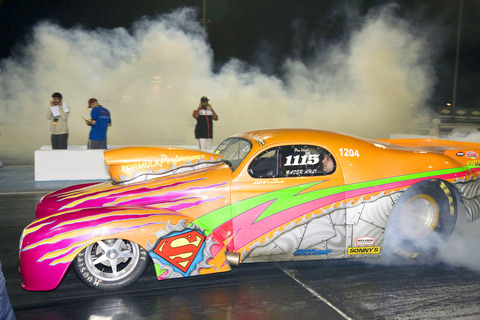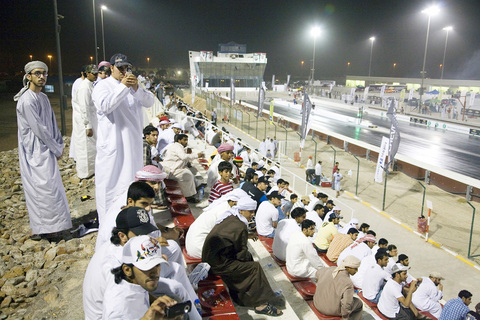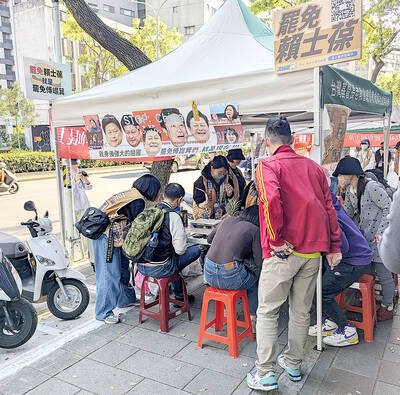Last month at the Emirates Motorplex, Ahmed Rashid al-Hajji sat in the stands with a small group of friends, quietly sizing up the competition. In March he had been out on the track himself and had planned to be racing in April.
"My car was ready until Wednesday night," he said. "I was tuning my car in my friend's garage, but there my luck was bad. So, inshallah," or God willing, "next time."
Not that long ago, Hajji would have been on Jumeirah Beach Road, a long stretch of highway that runs through Dubai, pitting his souped-up Nissan Skyline GT-R 33 against Lamborghinis and Mercedes-Benz SL55s. But drivers said that a crackdown on aggressive driving by the Dubai police discouraged street racing, so Hajji's Skyline sat at home for five months.

PHOTO: NY TIMES NEWS SERVICE
"Then one of my friends told me, 'Why don't you go to the track?"' he said, referring to the Emirates Motorplex. He took the suggestion and earned fourth place in his debut run.
There are many stories like his at the motorplex, a complex for 400m drag racing deep in the desert of the Umm al Qaywayn emirate (one of the seven that make up the United Arab Emirates), about an hour's drive northeast of Dubai. Although still relatively off the mainstream radar, the complex has become a safe way for Emirates gearheads to get off local roads to test their mettle on a track instead.
The track was created by Sheik Marwan al-Mualla, son of the ruler of Umm al Qaywayn and chairman of the Emirates Motor Sports Federation. He financed the building of the track with his own money, initially as a way for his friends and him to compete against one another. He sees the track as a way to reduce accidents by providing drivers with a safe environment.

PHOTO: NY TIMES NEWS SERVICE
"We have safety here, paramedics, an ambulance, and we give out trophies to the winners, something they can't get on the street," said Mualla, who no longer races on the track. "So what's the reason to race out on the main roads?"
Depending on whom you ask, Dubai is either a driver's dream or a nightmare. Dubai is among the few cities of its size — it has a population of about 1.35 million — to have been built almost entirely after the invention of the automobile, which is apparent in the city's general layout: a kind of Le Corbusien fantasy of skyscrapers, superhighways, sprawling shopping complexes and cities within cities, with little public transportation. Here, driving is a necessity.
Cars are more than a means of transportation, however: With a real growth rate in gross domestic product of 10.2 percent last year, local Emiratis are making a lot of money, and automobiles are a highly visible expression of wealth, power and ambition. Not surprisingly, this has helped make Dubai a playground for high-octane thrill-seekers once the sun goes down and the traffic thins out.
This aggressiveness makes Dubai a dangerous place to drive. Despite some successful efforts, including the recent installation of speed bumps along Jumeirah Beach Road, the Dubai Road and Transport Authority reported that road fatalities had increased by 32 percent from 2005 to 2006, with 312 people killed in Dubai last year. Judging by the stories of the drag racers at the Emirates Motorplex, the idea of competing in front of cheering crowds on Thursdays and Fridays once a month is capturing the imagination of former street racers. Similar factors in Southern California led to a proliferation of drag-racing parks in the 1950s in attempts to rein in street racing. In the UAE, this hasn't meant the end of street racing any more than it did in California, but according to Abdulla Essa, manager of the traffic department of Umm al Qaywayn, there has been a decrease in accidents among young drivers in the emirate over the last four years.
The motorplex, which also has tracks for motocross and all-terrain vehicles, has an overwhelmingly local feel. These aren't your average Pabst Blue Ribbon-drinking spectators — and it's not simply because there's no drinking allowed on the premises.
The crowd is mostly a sea of white dishdashas, the long robes worn by Emiratis, and brightly colored baseball caps. Juice boxes and sunflower seed shells litter the stands. Applause for the winning drivers is genuine, and spectators enjoy the spectacle, especially when a car blows an engine at the starting line or bursts into flames at the far end of the track. The track draws about 60 cars on qualification day and 40 on race day.
Ahmed al-Kamda, another Skyline driver from Dubai who races on the track, said he thought the popularity of the track was a good demonstration of the demand for a track among young street racers.
"As you can see, there is a huge market and demand for this sport, for drag racing," he said, gesturing to the cars and the crowd. "For them to open something and give us the opportunity so they can see our demands — you know, basically, if you have money to invest in a race car, you're not going to drag it on the street, you're going to bring it here."
Khaled al-Matrooshy, a mechanic from the nearby emirate of Ajman, agreed. His garage has been helping local drivers customize their hot rods since before the track opened six years ago. He said that one of his cars, a purple replica of a 1941 Willys with a Chevrolet engine, was jacked up to 2,300 horsepower.
"We have some young racers here, and they are doing well," Matrooshy said. "We were before racing in the street, but when they opened this track, we don't go anywhere outside anymore, all our races are inside the track. It's much safer."
Translating street bravado into safer behavior has been gradual, and racing as a proper sport still has not become established here. Ryan Trutch, an English emigre based in Dubai, who has been supplying safety equipment including helmets, fire-retardant suits and rollbars to drivers in the region for the last four years, said that the transition had been slow.
"In drag racing mostly, they have been very reluctant to wear the correct gear mainly because it's hot," he said.
Officials at the track said it operated according to international racing safety standards.
Obaid al-Ghawi, the track's general manager for the last two years, said he took great pride that this was a local operation. And it is one that, over the years, has managed to attract young fans and drivers from all over the region.
"Our own guys know how to do these things, and they are capable to run international races," he said, pointing out the racing marshals, the track safety and maintenance crews, the announcer and the drivers, almost all of whom were local. "This is when I feel happy."

That US assistance was a model for Taiwan’s spectacular development success was early recognized by policymakers and analysts. In a report to the US Congress for the fiscal year 1962, former President John F. Kennedy noted Taiwan’s “rapid economic growth,” was “producing a substantial net gain in living.” Kennedy had a stake in Taiwan’s achievements and the US’ official development assistance (ODA) in general: In September 1961, his entreaty to make the 1960s a “decade of development,” and an accompanying proposal for dedicated legislation to this end, had been formalized by congressional passage of the Foreign Assistance Act. Two

Despite the intense sunshine, we were hardly breaking a sweat as we cruised along the flat, dedicated bike lane, well protected from the heat by a canopy of trees. The electric assist on the bikes likely made a difference, too. Far removed from the bustle and noise of the Taichung traffic, we admired the serene rural scenery, making our way over rivers, alongside rice paddies and through pear orchards. Our route for the day covered two bike paths that connect in Fengyuan District (豐原) and are best done together. The Hou-Feng Bike Path (后豐鐵馬道) runs southward from Houli District (后里) while the

On March 13 President William Lai (賴清德) gave a national security speech noting the 20th year since the passing of China’s Anti-Secession Law (反分裂國家法) in March 2005 that laid the legal groundwork for an invasion of Taiwan. That law, and other subsequent ones, are merely political theater created by the Chinese Communist Party (CCP) to have something to point to so they can claim “we have to do it, it is the law.” The president’s speech was somber and said: “By its actions, China already satisfies the definition of a ‘foreign hostile force’ as provided in the Anti-Infiltration Act, which unlike

Mirror mirror on the wall, what’s the fairest Disney live-action remake of them all? Wait, mirror. Hold on a second. Maybe choosing from the likes of Alice in Wonderland (2010), Mulan (2020) and The Lion King (2019) isn’t such a good idea. Mirror, on second thought, what’s on Netflix? Even the most devoted fans would have to acknowledge that these have not been the most illustrious illustrations of Disney magic. At their best (Pete’s Dragon? Cinderella?) they breathe life into old classics that could use a little updating. At their worst, well, blue Will Smith. Given the rapacious rate of remakes in modern